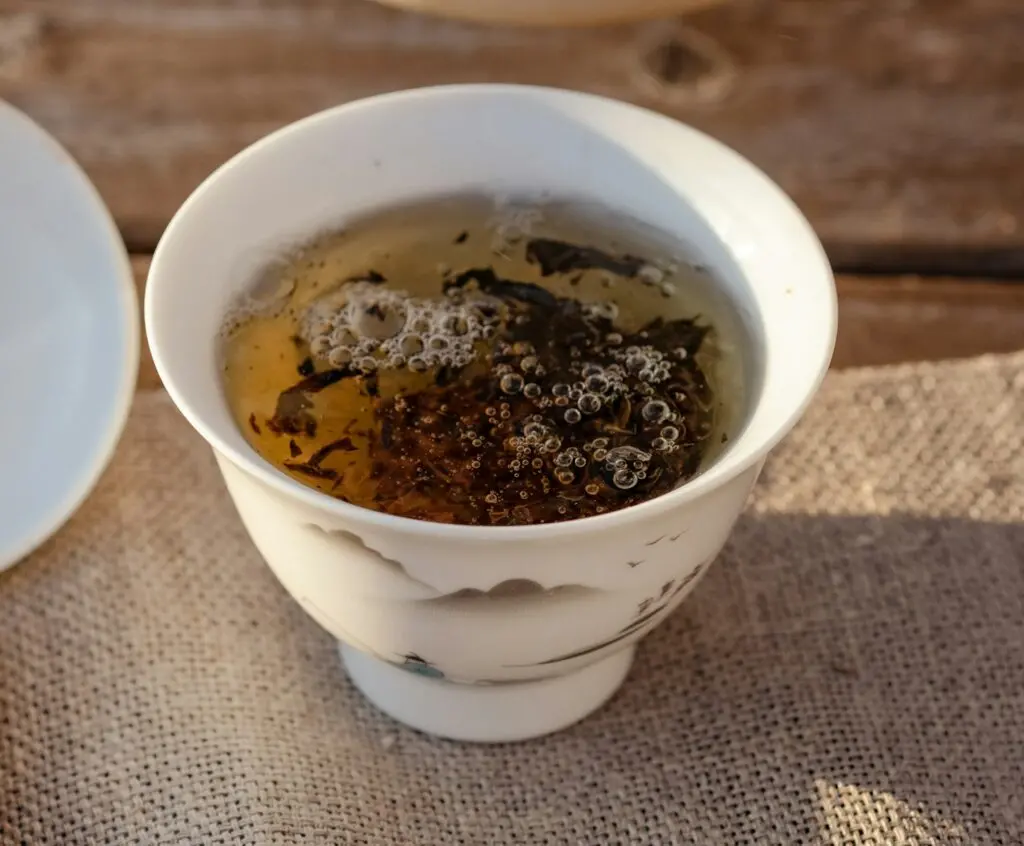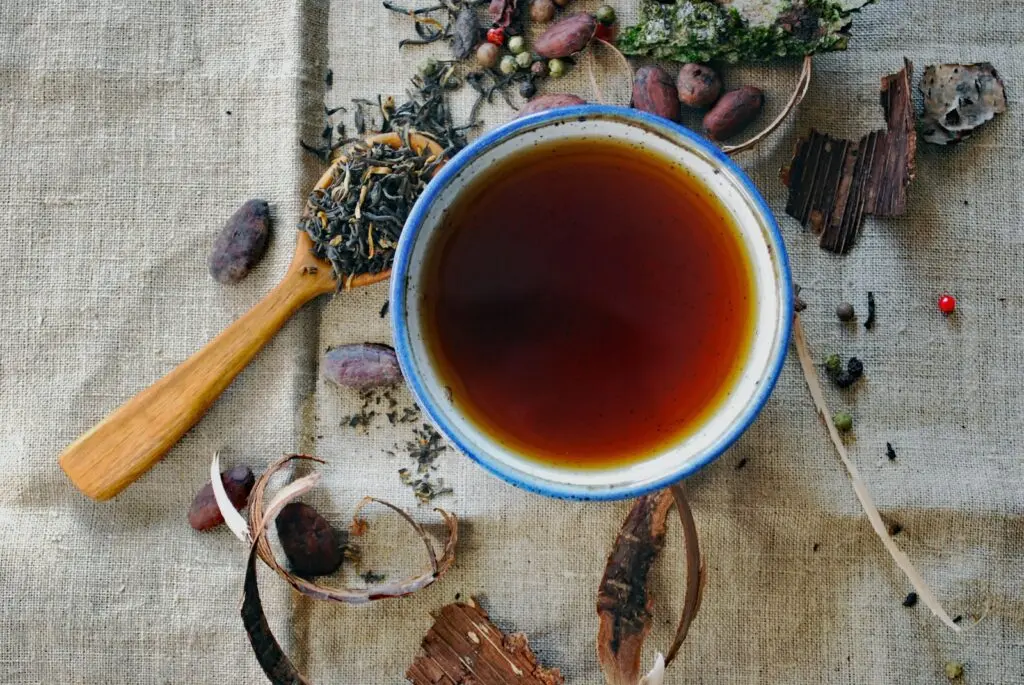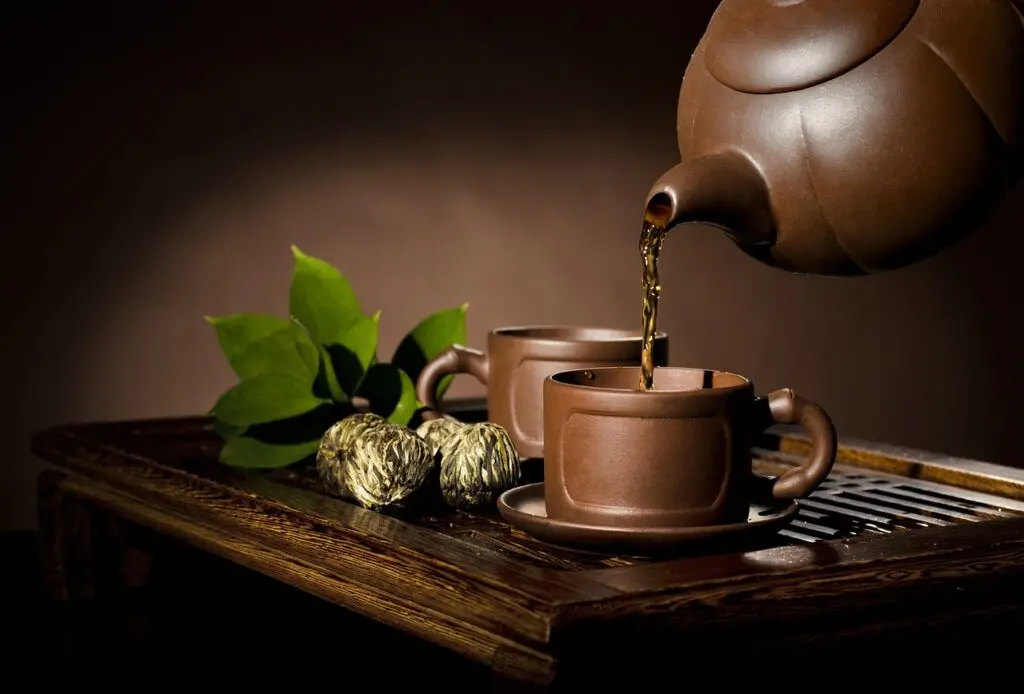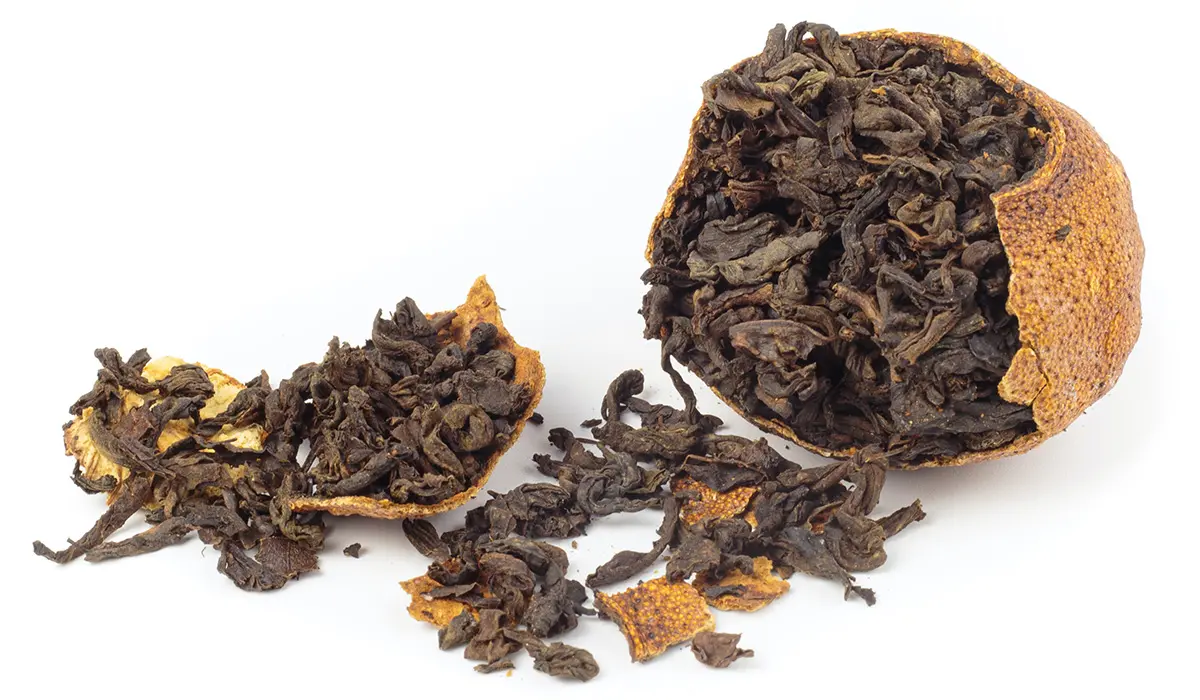Introduction to Puerh Tea
Puerh tea, often regarded as one of the most unique and complex teas in the world, originates from the lush, mountainous regions of Yunnan Province in China. With a history that traces back to the Tang Dynasty (618–907 AD), this fermented tea is not just a beverage but a cultural experience steeped in tradition. The name “Puerh” comes from the city of Puer, a vital trading post for tea along the ancient Tea Horse Road, where merchants would transport the prized leaves to various regions.
What sets Puerh tea apart from other types of tea is its distinctive fermentation process, which can lead to a diverse range of flavours and aromas. Puerh is often categorized into two main types: Sheng (raw) Puerh and Shou (ripe) Puerh. Sheng Puerh undergoes a natural aging process that can last for several years, resulting in a complex profile that evolves with time. In contrast, Shou Puerh is artificially fermented, giving it a darker colour and a smoother taste that appeals to many tea drinkers.
Often praised for its health benefits, Puerh tea is believed to aid digestion, promote weight loss, and even lower cholesterol levels. As interest in wellness continues to rise, Puerh has emerged as a favourite among health-conscious individuals.
The allure of Puerh tea is not just in its taste or health benefits; it’s also in its ability to connect drinkers to centuries of tradition and knowledge. Whether you’re a seasoned tea enthusiast or just beginning your journey, Puerh tea offers an inviting world of flavours and stories waiting to be explored.

Origins of Puerh Tea
The origins of Puerh tea can be traced back to the rich and ancient cultural tapestry of Yunnan Province, China. This region, renowned for its diverse flora and subtropical climate, has been the cradle of tea cultivation for thousands of years. The first documented mention of tea dates back to the 3rd century AD, but it wasn’t until the Tang Dynasty that Puerh began to gain prominence as a distinct tea type.
During the Tang Dynasty, the trade of Puerh tea flourished as it became a vital commodity along the Tea Horse Road, an ancient trade route that connected China with Tibet and beyond. This route was not only pivotal for commerce but also facilitated cultural exchange, making Puerh tea an integral part of daily life and spiritual practices in many communities. Monks in particular valued the tea for its stimulating properties, using it to stay alert during long meditation sessions.
The name “Puerh” itself is derived from the town of Puer, which served as a bustling marketplace where tea was processed, aged, and sold to travellers and merchants. The landscape surrounding Puer is dotted with ancient tea trees, some over a thousand years old, which contribute to the diverse flavour profiles of the tea produced in this region. These heirloom trees, primarily of the Camellia sinensis species, provide high-quality leaves that are essential for crafting premium Puerh.
Over the centuries, Puerh tea underwent various transformations and variations, leading to the development of both Sheng and Shou styles. Sheng Puerh was the traditional form, often compressed into bricks, cakes, or tuo cha (bird’s nest shapes) for easy transport and long-term aging. The natural process of oxidation and fermentation allowed it to evolve in complexity over the years. To meet growing demand and appeal to a broader audience, producers in the late 20th century developed Shou Puerh, refining a method to speed up fermentation.
As the world has become more interconnected, interest in Puerh tea has surged beyond China, reaching international tea aficionados keen to embrace its unique qualities. The rich storied past of Puerh, combined with its ongoing evolution, has solidified its status not just as a drink but as a cultural emblem that reflects the history and traditions of its land.
Today, Puerh tea continues to thrive, with both ancient craftspeople and modern producers striving to maintain the legacy of this beloved beverage while innovating new ways to enjoy its multifaceted character. As you sip on a cup of Puerh, you partake in a tradition that is centuries old, connecting you to a lineage of tea lovers who have cherished this elixir throughout the ages.
Types of Puerh Tea
Puerh tea, owing to its unique processing methods and rich history, comes in two primary types: Sheng (raw) and Shou (ripe). Each type possesses distinct characteristics that cater to a variety of palates and preferences. Understanding these differences is essential for any tea enthusiast looking to explore the complexities of this remarkable beverage.
Sheng Puerh (Raw Puerh)
Sheng Puerh is the traditional form of Puerh tea, often celebrated for its vibrant, evolving flavours. Made from freshly picked tea leaves, Sheng undergoes a natural aging process that develops its distinctive taste and aroma over time. The leaves are typically steamed, compressed into various forms such as cakes or bricks, and then allowed to age under specific conditions.
Flavor Profile
Sheng Puerh tends to be brighter and more astringent when young, with fresh, grassy notes that can evolve into deeper, more complex flavours as it ages. Older Sheng teas often display a rich symphony of textures and tastes, ranging from sweet and floral to earthy and woody, with an accompanying mellowness that enhances its character.
Aging Potential
One of the most intriguing aspects of Sheng Puerh is its ability to transform over time. Many tea enthusiasts regard it as an investment, as well-preserved cakes from esteemed producers can appreciate significantly in value. Depending on the storage conditions, the flavour can continue to develop over decades, providing a unique tasting experience with each passing year.
Shou Puerh (Ripe Puerh)
Shou Puerh emerged as a response to the increasing demand for quicker aging processes. Developed in the late 20th century, Shou Puerh involves an accelerated fermentation technique known as “wo dui” (which translates to “wet piling”) that simulates the aging process of Sheng. This method allows Shou Puerh to be consumed almost immediately after production, making it accessible for those who want an already matured flavour profile without waiting years.
Flavor Profile
Shou Puerh tends to have a darker, more robust profile characterized by deep, earthy flavours. It’s usually smoother and less astringent than its raw counterpart, often exhibiting notes of cocoa, damp forest floor, and dark fruits. These qualities make it an appealing choice for tea drinkers who prefer a rich, full-bodied cup.
Accessibility
With its relatively quicker production time, Shou Puerh has become widely popular among tea drinkers worldwide. It offers a reliable choice for those looking to enjoy a premium tea experience without the uncertainties linked to aging Sheng Puerh. Moreover, the affordability of many Shou options makes them an attractive entry point for newcomers to the Puerh tea community.
Other Variations
While Sheng and Shou Puerh are the primary categories, the world of Puerh tea is rich with regional varieties and flavour nuances that can vary based on factors like terroir, the specific tea trees used, and the methods of production. Some producers also offer flavoured or blended Puerhs, incorporating ingredients such as herbs, fruits, or spices to create bespoke tasting experiences.
In conclusion, the types of Puerh tea provide a delightful exploration of flavours and traditions that cater to a wide array of tastes. Whether you prefer the aged complexity of Sheng or the robust earthiness of Shou, Puerh tea invites you to savour its unique qualities while honouring the centuries of craftsmanship behind each cup.
Health Benefits of Puerh Tea
Puerh tea is not just celebrated for its rich flavours and unique aging process but also for an array of potential health benefits that have intrigued both tea enthusiasts and researchers alike. Here, we delve into the notable advantages associated with consuming this distinctive beverage.
1. Digestive Support
One of the most well-known benefits of puerh tea is its positive impact on digestion. Traditionally consumed after meals, Puerh is believed to aid in breaking down fats and improving digestion due to its rich content of enzymes. Additionally, the presence of probiotics, especially in Shou Puerh, can promote gut health by enhancing the balance of beneficial bacteria.
2. Weight Management
Research suggests that Puerh tea may assist in weight management. The tea has been cited for its potential to boost metabolism and promote fat oxidation. Some studies indicate that daily consumption could facilitate weight loss by helping to regulate cholesterol levels and stabilize blood sugar, making it an appealing option for those seeking to maintain a healthy lifestyle.
3. Cardiovascular Health
Puerh tea is rich in bioactive compounds known as polyphenols, which are known for their antioxidant properties. These compounds can help reduce LDL cholesterol levels and improve overall heart health. Regularly incorporating Puerh into your diet may be beneficial to maintaining healthy blood pressure and reducing the risk of cardiovascular diseases.
4. Stress Relief and Mental Clarity
Like many herbal teas, Puerh may also support mental clarity and relaxation. The presence of L-theanine, an amino acid commonly found in tea, has been shown to promote a sense of calm while enhancing focus. Sipping on a warm cup of Puerh after a long day can help alleviate stress and provide a moment of tranquillity.
5. Antioxidant Benefits
Rich in antioxidants, Puerh tea contributes to the body’s fight against free radicals, which can cause cellular damage and lead to chronic diseases. Regular consumption of antioxidant-rich foods and beverages, including Puerh tea, can help combat oxidative stress and bolster overall health.

Brewing Techniques for Puerh Tea
Brewing Puerh tea is both an art and a science, offering various methods to extract the optimal flavours and health benefits from the leaves. Whether you are new to Puerh or a seasoned enthusiast, understanding the different brewing techniques can elevate your tea experience. Below are some popular methods to brew Puerh tea, along with tips to help you master each one.
1. Gongfu Cha: The Traditional Method
Gongfu Cha, or “making tea with skill,” is the traditional Chinese brewing technique that emphasizes precision and artistry. This method is ideal for Puerh tea as it allows for multiple infusions, revealing the tea’s complex flavours over several brews. Using a gong fu tea set enhances this experience, providing the necessary tools to masterfully prepare and enjoy the tea.
- Equipment Needed: A Yixing teapot or a small Gaiwan (lidded bowl), teacups, a tea pitcher, and a kettle.
- Steps:
- Warm Your Vessel: Pour hot water into the teapot or Gaiwan to warm it, then discard the water.
- Measure the Tea: Use around 5-7 grams of Puerh tea for every 150-200 ml of water.
- Rinse the Leaves: Pour boiling water over the dry leaves, allowing them to steep for about 10 seconds, then discard the water. This step helps awaken the tea and remove any dust.
- First Brew: Add hot water (around 95-100°C / 203-212°F) and steep for 20-30 seconds. Adjust the time based on your taste preference.
- Multiple Infusions: Continue to steep using the same leaves, increasing the time by 5-10 seconds with each infusion. Enjoy the evolving flavours in each cup!
2. Western Style: Simplified Brewing
For those who prefer a more straightforward approach, the Western-style brewing method offers convenience without compromising flavour.
- Equipment Needed: A teapot or infuser, teacups, and a kettle.
- Steps:
- Measure the Tea: Use about 3-5 grams of Puerh tea per cup (approximately 250 ml of water).
- Boil Water: Use boiling water (95-100°C / 203-212°F).
- Steep Time: Allow the tea to steep for 3-5 minutes, depending on your desired strength. You can adjust the time based on the type of Puerh (Sheng vs. Shou).
- Serve: Once steeped, pour the tea into cups and enjoy. The leaves can be reused for subsequent infusions.
3. Cold Brewing: A Refreshing Alternative
Cold brewing is a fantastic way to highlight the smooth, mellow flavours of Puerh tea, making it an excellent choice for warm days.
- Equipment Needed: A cold brew pitcher a simple jar, and a kettle.
- Steps:
- Prepare the Tea: Use about 4-6 grams of Puerh tea for every 500 ml of cold water.
- Combine: Place the tea leaves in the pitcher or jar, add cold water, and stir gently to ensure the leaves are fully immersed.
- Steep Time: Let it steep in the refrigerator for at least 6-12 hours. The longer you steep, the richer the flavour will be.
- Strain and Serve: After steeping, strain the tea into glasses. You can serve it over ice or as is, making for a refreshing drink with subtle earthy notes.
Tasting Notes: What to Expect from Puerh Tea
When it comes to tasting Puerh tea, enthusiasts are often met with an extraordinary range of flavours and aromas that can vary significantly depending on the type of Puerh, its age, and the specific processing methods employed. Here’s a detailed look at what you can expect when sipping this unique tea.
Aromas: Earthy and Complex
One of the first aspects that Puerh tea aficionados notice is its distinctive aroma. Freshly brewed Sheng (raw) Puerh often presents bright, floral notes with hints of grass, herbs, and a touch of sweetness, reminiscent of a spring meadow. In contrast, Shou (ripe) Puerh usually features deeper, earthier aromas akin to wet soil, forest moss, or aged wood, presenting a warm, comforting scent that invites you to take a sip.
Flavor Profile: A Journey through Sweetness, Bitterness, and Umami
Puerh tea is celebrated for its complex flavour profile, which can evolve over multiple infusions. Here are some common flavour notes:
- Sheng Puerh: The flavour tends to be bright and invigorating, often exhibiting a natural sweetness, followed by a subtle bitterness that helps balance the experience. As you steep the leaves longer or infuse them multiple times, expect to discern nuances like floral, fruity, and herbal notes, with some varieties even presenting a faint smokiness or a buttery texture after aging.
- Shou Puerh: Known for its smoothness, Shou Puerh generally offers a more robust and rounded flavour. The taste is often described as woody and earthy, with rich, molasses-like sweetness and a touch of dark chocolate or tobacco, creating a satisfying and comforting experience on the palate. The umami richness and minimal bitterness make it appealing, especially for those new to Puerh.
Mouthfeel: Smooth and Coating
Beyond taste and aroma, the mouthfeel of Puerh tea adds another layer to its appeal. Most Puerh teas exhibit a silky, almost creamy texture that coats the palate, making each sip an indulgent experience. Sheng Puerh may have a slightly more astringent quality due to its youth, while Shou Puerh typically feels more rounded and soft.
Aftertaste: Lingering and Refreshing
One of the most celebrated aspects of Puerh is its enduring aftertaste, known as “hui gan.” This refers to the pleasant, lingering sweetness that can sometimes arise even after the liquid has been swallowed. With Sheng Puerh, the aftertaste may be bright and fresh, often leaving a cooling sensation akin to mint. In contrast, Shou Puerh tends to leave a warm, earthy lingering sensation, inviting the drinker to savour the memories of each sip.

Storing Puerh Tea
Proper storage is essential to maintain the unique qualities of Puerh tea, as it can age beautifully over time, developing richer flavours and aromas. However, improper storage can lead to degradation and loss of its characteristic taste. Here are some key considerations for preserving your Puerh tea:
1. Choose the Right Containers
The container you use can significantly impact the flavour and quality of your Puerh tea. Here are some options:
- Breathable Materials: Ideally, Puerh tea should be stored in a breathable container, such as a ceramic jar or a cotton bag, to allow proper airflow while preventing moisture buildup. Avoid airtight containers as they can trap humidity and lead to mold growth.
- Avoid Plastic: It’s best to steer clear of plastic containers, which can impart unwanted flavours and aromas to the tea.
- Glass or Clay: Glass jars are a good option, provided they are not sealed tightly. Clay containers can be excellent as they allow for some air exchange while also providing a certain degree of moisture regulation.
2. Consider the Environment
Environmental factors play a crucial role in the aging process of Puerh tea. Here are some conditions to keep in mind:
- Temperature: Store Puerh tea in a cool, stable environment away from direct sunlight and heat sources. Ideal temperatures should be around 20-25 degrees Celsius (68-77 degrees Fahrenheit). Large temperature fluctuations can negatively affect the tea’s quality.
- Humidity: Maintaining the proper humidity level is vital for preserving Puerh tea. Aim for a humidity range of 50-70%. High humidity can lead to mould, while low humidity may cause the tea to dry out and lose its flavour.
- Light Exposure: Keep your Puerh tea away from direct sunlight and bright artificial lights. Light can cause the tea to degrade over time, diminishing its flavours and aromas.
3. Periodic Inspection
Regularly check on your stored Puerh tea. Look for any signs of mould or unusual odours, which might indicate that the tea is not stored properly. It’s also a great opportunity to allow you to assess the tea’s maturity and adjust its storage conditions if needed.
4. Avoid Strong Odors
Puerh tea can easily absorb strong odours from its surroundings, which can affect its flavour. Store it away from spices, cleaning supplies, and other fragrant items to preserve its natural aroma.
5. Experiment with Aging
One of the unique aspects of Puerh is its ability to age, which can enhance its flavours and complexity. Feel free to experiment with different aging environments or conditions to see how your tea changes over time. Just be mindful to keep a log of your observations, as this can help inform your future purchases and storage practices.
In summary, by choosing the right container, ensuring ideal environmental conditions, periodically checking your tea, and protecting it from strong odours, you can enjoy your Puerh tea’s evolving flavours and character for years to come. With proper care, your Puerh tea can become not only a delightful beverage but also a cherished part of your tea collection.
Conclusion: Embracing the Puerh Experience
Puerh tea is more than just a beverage; it’s a journey through time, tradition, and taste. From its rich historical roots in the Yunnan province to the profound flavours that develop through careful aging, Puerh offers a unique and immersive experience that tea enthusiasts around the world cherish.
Savouring Complexity
As you embrace the Puerh experience, allow yourself to explore its complex flavour profile, which can evolve dramatically with each steeping. Whether you opt for a young sheng Puerh with its vibrant, fresh tones or an aged shou Puerh boasting deep, earthy richness, every cup invites a moment of contemplation. The tactile sensations and aroma that accompany the taste transport you to the lush landscapes of Yunnan, enriching your appreciation for this ancient practice.
Cultivating Ritual
Incorporating Puerh tea into your daily routine can enhance mindfulness and create a tranquil ritual amidst the hustle of modern life. The process of brewing Puerh—selecting your leaf, controlling water temperature, timing your steeps—becomes a meditative act that encourages you to slow down and savour not just the tea, but the moment. Consider inviting friends or family to join you in this ritual, sharing your discoveries and fostering connections over a pot of fragrant Puerh.
Continual Discovery
The world of Puerh tea is vast, with countless varieties and brands waiting to be explored. By attending tea tastings, participating in online communities, or even visiting tea plantations in Yunnan, you can deepen your knowledge and appreciation for this remarkable tea. Embrace the journey of learning as you discover the stories behind each tea, enriching your experience with insights into its crafting and cultural significance.
A Personal Connection
Ultimately, Puerh tea can cultivate a personal connection that transcends mere consumption. As the leaves breathe and age, they become a reflection of your journey, highlighting your evolving taste preferences and experiences. Each cup serves as a reminder of the rich culture that this tea embodies—centuries of tradition, shared stories, and an appreciation for craftsmanship.
In conclusion, by embracing the Puerh experience, you welcome an iconic chapter in the world of tea that is steeped in history, flavour, and community. Whether you’re a novice exploring the nuances of taste or a seasoned drinker savouring a well-aged blend, the world of Puerh tea invites you to indulge your senses, cultivate new rituals, and forge a deeper connection to the ancient art of tea drinking. So go ahead, pour yourself a cup, and let the journey unfold.



Leave a Reply
You must be logged in to post a comment.